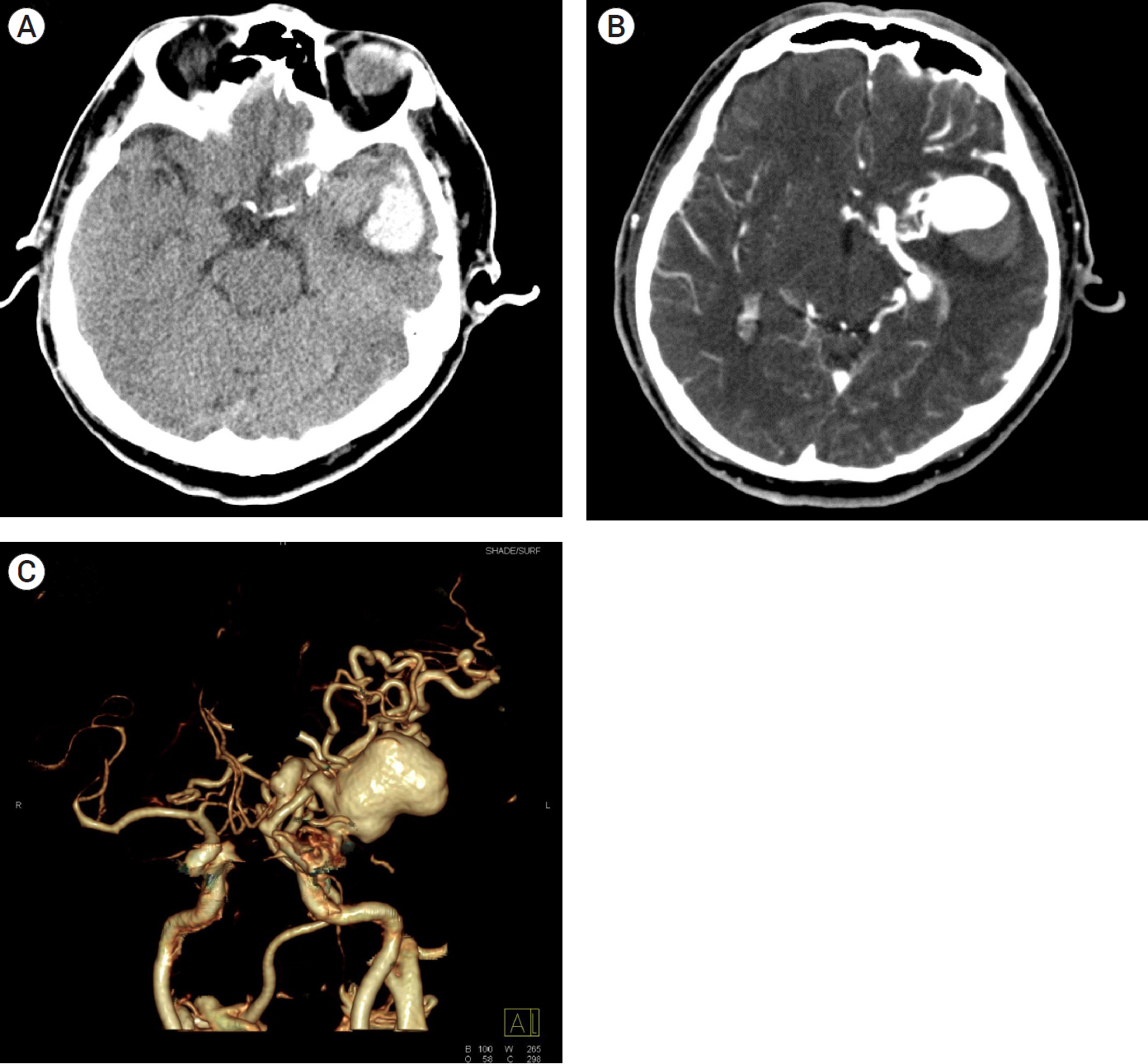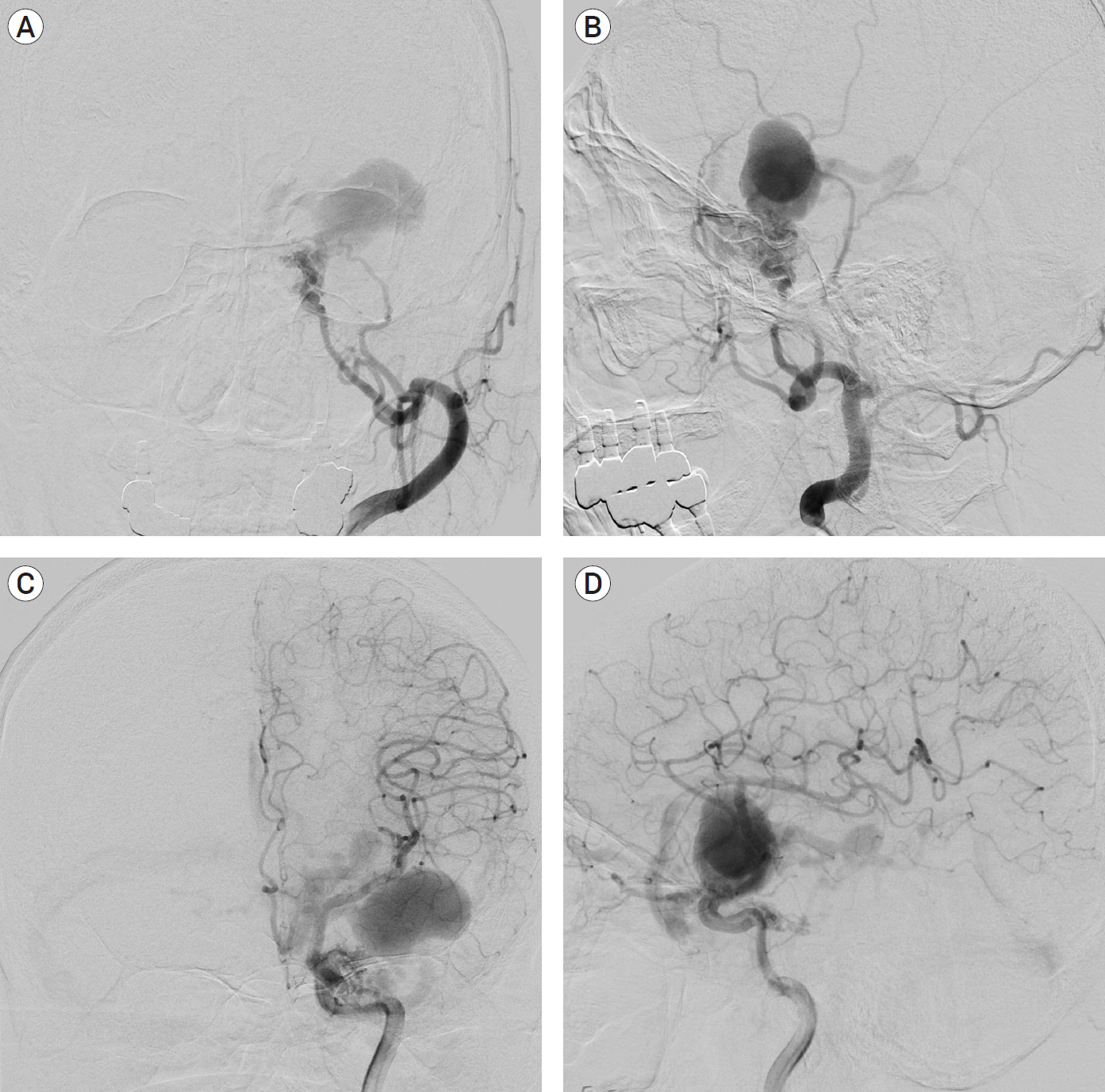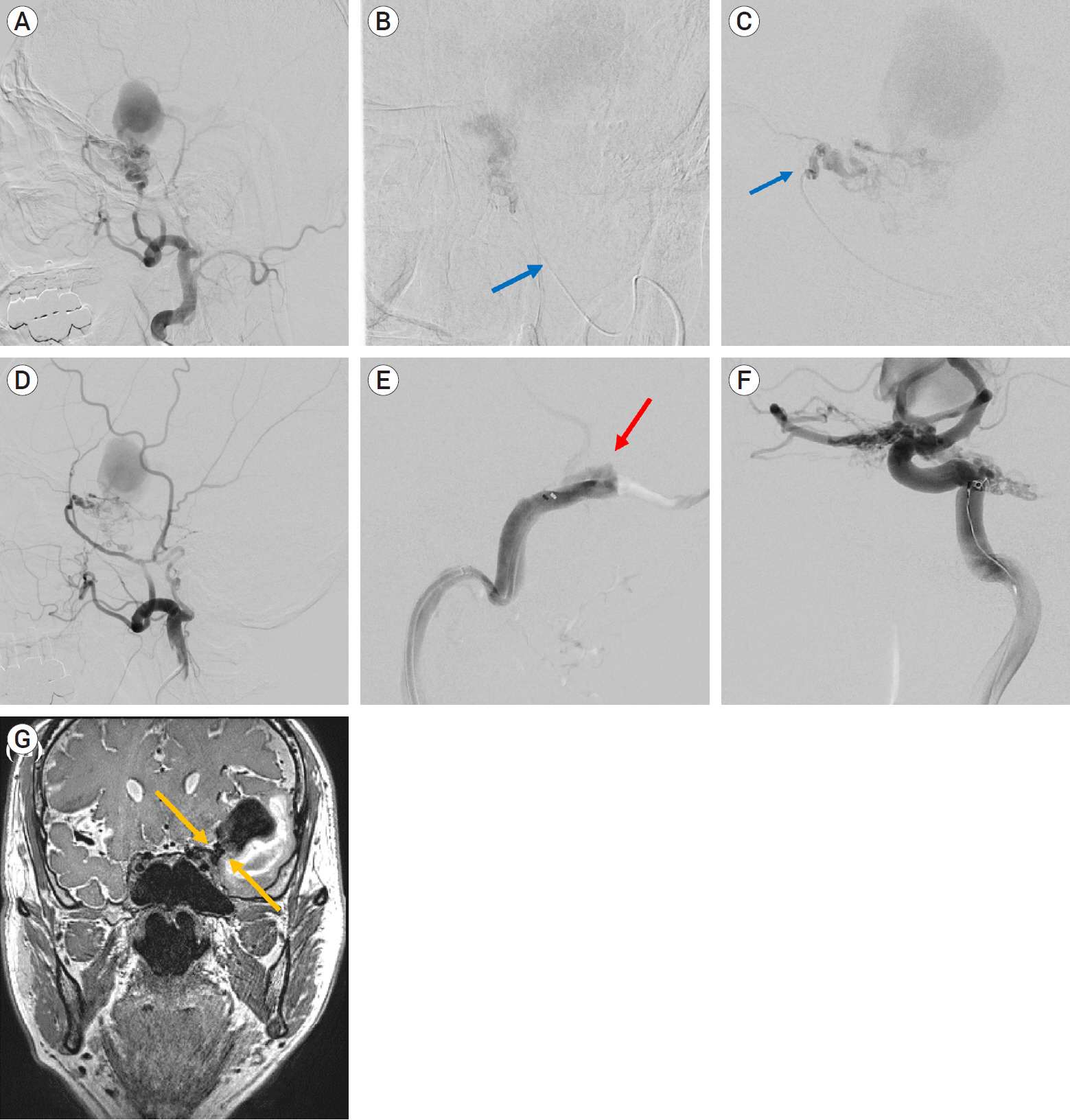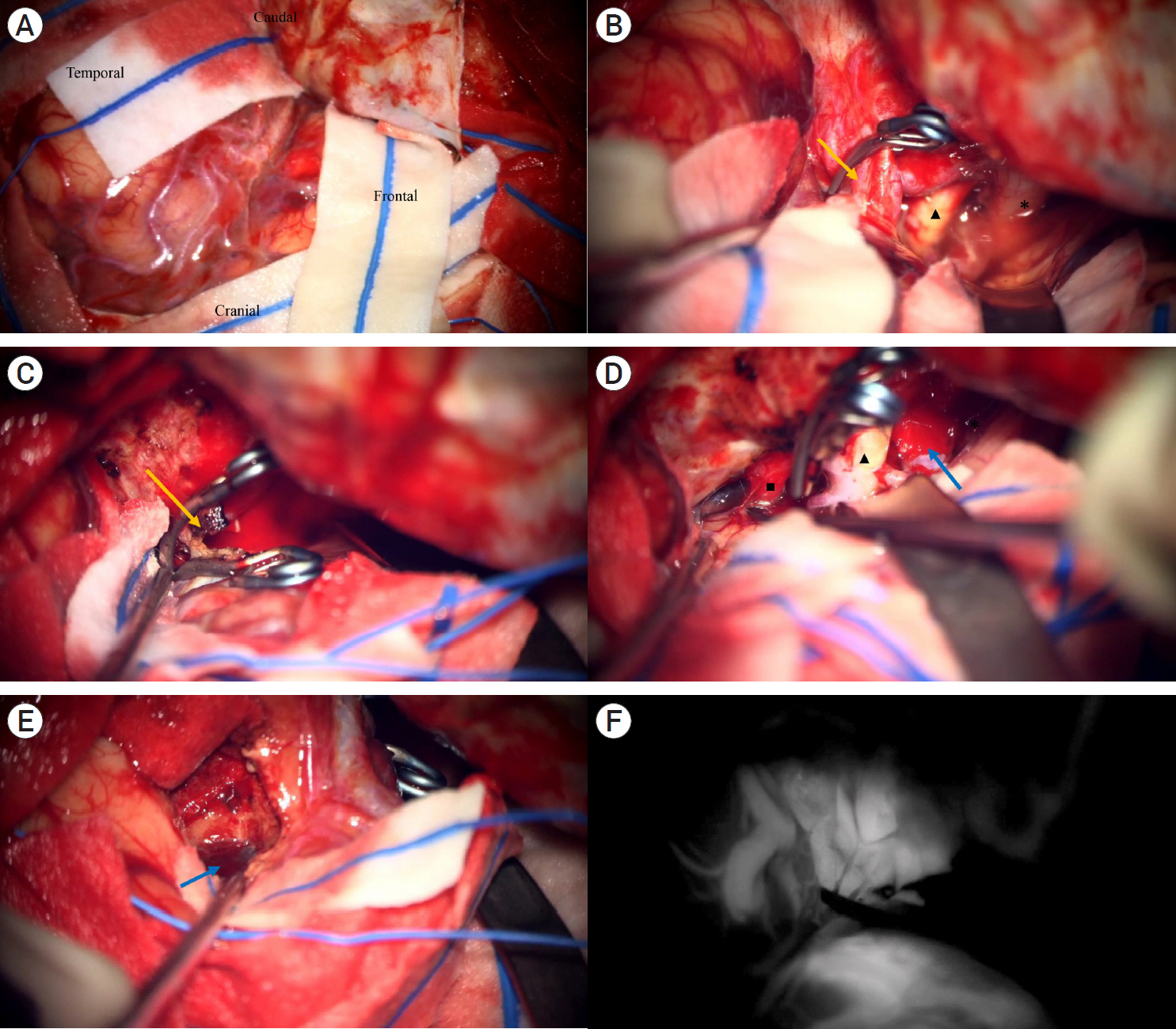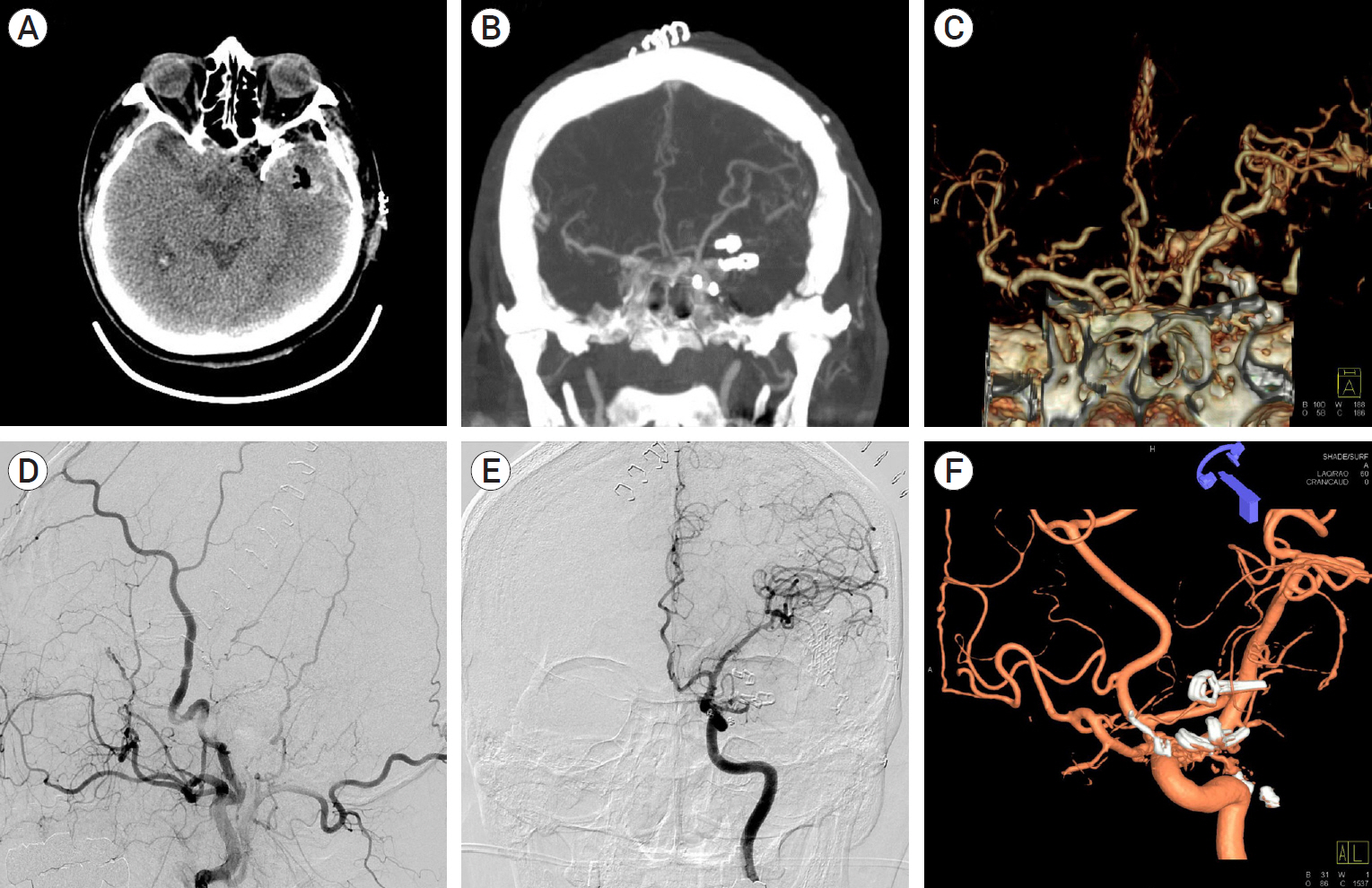J Cerebrovasc Endovasc Neurosurg.
2021 Mar;23(1):41-48. 10.7461/jcen.2020.E2020.08.001.
Microsurgical treatment of lateral cavernous sinus wall dural arteriovenous fistula with large venous aneurysm: A case report
- Affiliations
-
- 1Department of Neurosurgery, Asan Medical Center, University of Ulsan, College of Medicine, Seoul, Korea
- 2Department of Radiology, Asan Medical Center, University of Ulsan, College of Medicine, Seoul, Korea
- KMID: 2514337
- DOI: http://doi.org/10.7461/jcen.2020.E2020.08.001
Abstract
- We report a case of lateral cavernous sinus wall dural arteriovenous fistula (DAVF) accompanied large venous aneurysm which is presented intracerebral hemorrhage (ICH). A 58-year-old male patient came to emergency department for acute onset of headache and dysarthria. In brain computed tomography scan, large left temporal lobe ICH was noted. In transfemoral cerebral angiography, multiple arteries from external carotid artery and left internal carotid artery (ICA) fed arteriovenous shunt. This shunt was drained through cavernous sinus with enlarged multiple cortical veins. One large venous aneurysm was estimated as bleeding focus for ICH. Considering ICH and high flow shunt, we planned urgent treatment to reduce flow of arteriovenous shunt. However, transvenous embolization was failed due to tortuous venous anatomy. Therefore, we planned craniotomy and microsurgical treatment. There was engorged small vessel in lateral wall of cavernous sinus and vascular trunk which is fistulous connection was noted. Fistula connection was obliterated and disconnected after coagulation. In postoperative image, fistula was completely disappeared and there was no cortical venous reflux, also large venous aneurysm was disappeared. Patient recovered very well without new neurological deficits. We reported successfully treated lateral cavernous sinus wall DAVF by combined endovascular and transcranial-microsurgical treatment.
Figure
Reference
-
1. Borden JA, Wu JK, Shucart WA. A proposed classification for spinal and cranial dural arteriovenous fistulous malformations and implications for treatment. J Neurosurg. 1995; Feb. 82(2):166–79.
Article2. Cognard C, Januel AC, Silva NA Jr, Tall P. Endovascular treatment of intracranial dural arteriovenous fistulas with cortical venous drainage: new management using Onyx. AJNR Am J Neuroradiol. 2008; Feb. 29(2):235–41.
Article3. Daniels DJ, Vellimana AK, Zipfel GJ, Lanzino G. Intracranial hemorrhage from dural arteriovenous fistulas: clinical features and outcome. Neurosurg Focus. 2013; May. 34(5):E15.
Article4. Gandhi D, Chen J, Pearl M, Huang J, Gemmete JJ, Kathuria S. Intracranial dural arteriovenous fistulas: classification, imaging findings, and treatment. AJNR Am J Neuroradiol. 2012; Jun. 33(6):1007–13.
Article5. Lamin S, Chew HS, Chavda S, Thomas A, Piano M, Quilici L, et al. Embolization of intracranial dural arteriovenous fistulas using PHIL liquid embolic agent in 26 patients: a multicenter study. AJNR Am J Neuroradiol. 2017; Jan. 38(1):127–31.
Article6. Roy D, Raymond J. The role of transvenous embolization in the treatment of intracranial dural arteriovenous fistulas. Neurosurgery. 1997; Jun. 40(6):1133–41. discussion 1141.
Article7. Tomak PR, Cloft HJ, Kaga A, Cawley CM, Dion J, Barrow DL. Evolution of the management of tentorial dural arteriovenous malformations. Neurosurgery. 2003; Apr. 52(4):750–60. discussion 60-2.
Article8. Uchiyama T, Horiuchi T, Murata T, Hongo K. Dural arteriovenous fistula between inferolateral trunk of the internal carotid artery and superficial sylvian vein. Neurol Med Chir (Tokyo). 2011; Sep. 51(9):642–4.
Article9. Ushikoshi S, Honma T, Uchida K, Yasuda H, Ajiki M. Dural arteriovenous fistula at the anterior clinoid process draining directly into the superficial middle cerebral vein. Neurol Med Chir (Tokyo). 2013; Mar. 53(3):195–8.
Article10. Watanabe J, Maruya J, Nishimaki K. Surgical treatment of a dural arteriovenous fistula in the sphenoid wing with a unique drainage pattern through the basal vein of Rosenthal. NMC Case Rep J. 2015; Jun. 2(3):88–92.
Article
- Full Text Links
- Actions
-
Cited
- CITED
-
- Close
- Share
- Similar articles
-
- Transvenous Embolization of Cavernous Sinus Dural Arteriovenous Fistula Using the Direct Superior Ophthalmic Vein Approach: A Case Report
- Borden Type I Sigmoid Sinus Dural Arteriovenous Fistula Presenting as Subarachnoid Hemorrhage from a Feeding Artery Aneurysm of the Anterior Inferior Cerebellar Artery: A Case Report
- Endovascular management of cavernous sinus dural arteriovenous fistulas: Overall review and considerations
- A Case of Dural Arterio-venous Malformation Involving the Cavernous Sinus
- Surgical Treatment of Carotid-Cavernous Fistula and Intracranial Dural Arteriovenous Malformations

